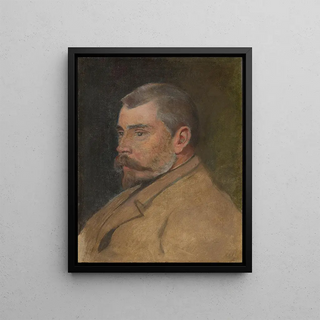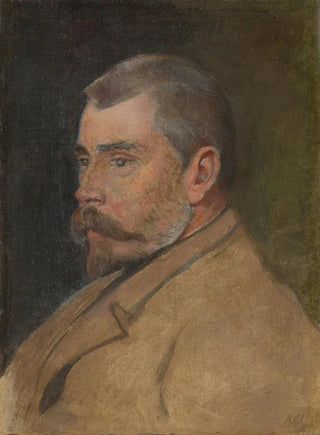Art print | Portrait of Brother-in-law Štefan Čabel - Ladislav Mednyánszky


View from behind

Frame (optional)
In the vast panorama of art history, certain works stand out for their ability to capture the very essence of humanity. The art print Portrait of the brother-in-law Štefan Čabel by Ladislav Mednyánszky is one of those creations that, through its intensity and depth, invites prolonged contemplation. This portrait, created by the Hungarian artist Ladislav Mednyánszky, goes beyond merely depicting a face; it evokes an inner world, a complex psychology that resonates with anyone who takes the time to observe it. Through this painting, Mednyánszky offers us a window into a bygone era, while revealing universal emotions that transcend time.
Style and uniqueness of the work
Mednyánszky's style is often characterized by poignant realism, mastery of colors and shadows that give his characters an almost tangible life. In the portrait of Štefan Čabel, the artist succeeds in blending a realistic approach with a touch of impressionism, creating an atmosphere that is both intimate and dynamic. The nuances of light that caress the subject's face, as well as the meticulous details of the clothing, testify to attentive observation and a deep respect for the personality he portrays. This art print is not just a simple image; it suggests a narrative, a story that each viewer can interpret in their own way. Mednyánszky manages to capture fleeting moments, ephemeral emotions, while anchoring them in a tangible reality.
The artist and his influence
Ladislav Mednyánszky, an emblematic figure of Hungarian painting, established himself as a master of portraiture and landscape. Born in 1852, he was influenced by the major artistic currents of his time, notably realism and impressionism. His work is characterized by profound humanism, a sensitivity expressed through careful attention to detail and light. Mednyánszky was also an unwavering traveler, exploring various European landscapes that enriched his palette and artistic vision. His influence endures, inspiring many contemporary artists who

Matte finish

View from behind

Frame (optional)
In the vast panorama of art history, certain works stand out for their ability to capture the very essence of humanity. The art print Portrait of the brother-in-law Štefan Čabel by Ladislav Mednyánszky is one of those creations that, through its intensity and depth, invites prolonged contemplation. This portrait, created by the Hungarian artist Ladislav Mednyánszky, goes beyond merely depicting a face; it evokes an inner world, a complex psychology that resonates with anyone who takes the time to observe it. Through this painting, Mednyánszky offers us a window into a bygone era, while revealing universal emotions that transcend time.
Style and uniqueness of the work
Mednyánszky's style is often characterized by poignant realism, mastery of colors and shadows that give his characters an almost tangible life. In the portrait of Štefan Čabel, the artist succeeds in blending a realistic approach with a touch of impressionism, creating an atmosphere that is both intimate and dynamic. The nuances of light that caress the subject's face, as well as the meticulous details of the clothing, testify to attentive observation and a deep respect for the personality he portrays. This art print is not just a simple image; it suggests a narrative, a story that each viewer can interpret in their own way. Mednyánszky manages to capture fleeting moments, ephemeral emotions, while anchoring them in a tangible reality.
The artist and his influence
Ladislav Mednyánszky, an emblematic figure of Hungarian painting, established himself as a master of portraiture and landscape. Born in 1852, he was influenced by the major artistic currents of his time, notably realism and impressionism. His work is characterized by profound humanism, a sensitivity expressed through careful attention to detail and light. Mednyánszky was also an unwavering traveler, exploring various European landscapes that enriched his palette and artistic vision. His influence endures, inspiring many contemporary artists who






